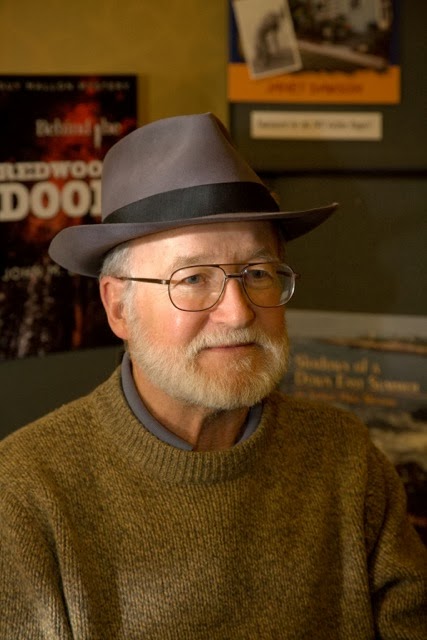It is an honor and a pleasure to be a guest poster on J.R.
Lindermuth’s blog. John Lindermuth is an author I admire, and I happen to know
he enjoys doing research into the past to give added interest and information
to his historical novels. I’ve never really considered myself a historical
novelist, but I do enjoy the research involved in telling a story. Parts of my
stories come from memory, parts from imagination, and parts come from research.
This has been especially true of my newest book. Since that story takes place
forty years ago, it almost qualifies as a historical novel. And what a wild
time that was, even in a sedate, middle-class college town.…
Hooperman: A Bookstore Mystery, is set in and near Maxwell’s Books,
a fictitious store in Palo Alto,
Cal., during the summer of
1972. Palo Alto,
back then, was not the epicenter of technology and business that it is today.
It was still an upper-middle-class college town, although it was becoming more
and more stirred up with important and divisive issues
of the times.
Return with me now to those daring days of yesteryear.
A lot is going on during the summer of 1972: Jane Fonda is
touring North Vietnam,
George Carlin gets arrested for obscenity, and Bobby Fischer battles with Boris
Spassky over the chessboard in Iceland.
Nixon is still president, although this is the summer of the Watergate
break-in, which will spell the end of Nixon’s presidency.
This is a time of big social and political causes. The war
in Vietnam is still raging, as is the anti-war protest, along with other
movements, such as black power, gay pride, women’s liberation, and the human
potential movement, not to mention the sexual revolution. Maxwell’s Books, the
locale of most of Hooperman, feels
like the meeting place for all these movements. It is a bookstore owned by a
celebrity pacifist, staffed by artists, musicians, dopers, dreamers, and poets.
Some of that summer’s best-sellers are: Jonathan Livingston Seagull, The Joy of Sex, Be Here Now, The Pentagon
Papers, Open Marriage, and Another
Roadside Attraction. Customers who frequent Maxwell’s Books include Joan
Baez, Ken Kesey, Stephen Stills, Jerry Garcia, and Wallace Stegner.
I invite you to climb aboard the time machine known as a
historical novel, in this case Hooperman:
A Bookstore Mystery, and go back in time to the summer of 1972. I guarantee
you a good ride!
Meanwhile, you might enjoy meeting a couple of the older
members of the Maxwell’s staff:
Hooperman
worked at the store almost a week before he caught another shoplifter, a
teenager who had stuffed a Zap Comix under his Steely Dan concert tee shirt.
The comic book was priced at half a dollar, so Hoop earned an extra twenty-five
cents that day. Elmer was good about paying him his five dollars a day, and
Hoop was still having a good time, so he decided to continue working at
Maxwell’s Books as long as he could afford it.
It was easy
work, although it was boring as dust except when he played like a customer and
actually got interested in the books he was guarding. Hoop made friends with
more of the staff, including a couple of Elmer’s old conscientious objector
cronies from WWII, Pete Blanchard and Jack Davis, who squabbled over the right
to take care of the Political Science section. Pete was a socialist, Jack was
an anarchist, and their arguments stopped traffic all over the store. Neither
one of them wanted anything to do with the section that Charley David had named
The Times They Are A-Changin’. Kids’ stuff, they called it. Kids don’t know
beans, they said. Charley was a painter whose jeans looked like a used palette.
“Kids these
days,” Pete muttered one day when he and Jack were elbowing each other in the
Politics aisle. Hooperman stood by, supposedly doing his job, mainly
eavesdropping. Pete wore a jacket and tie to work and looked like a rumpled
professor.
“Aaaah, give it
a rest,” Jack countered. “You political dinosaur.” He hitched up his overalls
and lit a Lucky Strike.
“No smoking in
the store.”
“Says who?”
“Can’t you see
this place is a tinderbox, Jack? You want to burn the store down?”
Jack turned to Hoop, raised his eyebrows,
wiggled his cigarette, and said, “Now there’s an idea.”
Book
synopsis
Hooperman: A Bookstore Mystery celebrates the joy of books and bookselling and also explores the
many ways people get into trouble—deadly serious trouble—when they fail to
communicate.
Hooperman Johnson is a tall,
bushy-bearded man of few words. He works as a bookstore cop, catching
shoplifters in the act. It’s a difficult job for a man with a severe stammer,
but somebody’s got to do it, because Maxwell’s Books is getting ripped off
big-time. And, more and more, it looks like the thief works for the store.
Set
in the summer of 1972, the summer of the Watergate break-in, Hooperman is a bookstore mystery without
a murder, but full of plot, full of oddball characters, full of laughs, and
full of love, some of it poignant, some of it steamy.
“Pleasant
and unusually good-natured, this novel from Daniel harkens back to a time when
printed books mattered and an independent bookstore could be a social club for
passionately eccentric bibliophiles.” —Publishers Weekly,
starred review
Buy or order Hooperman: A Bookstore Mystery from your local bookstore, from
Amazon, or direct from the publisher:
Oak Tree Press
1820 W.
Lacey Blvd. #220
Hanford, CA
93230
217-825-4489
Publisher@oaktreebooks.com
For more info about Hooperman: A Bookstore Mystery:
www.danielpublishing.com/jmd/hooperman.html
•••
Author bio
John M. Daniel is a lifelong bibliophile, having worked in eight
bookstores. He’s also the author of fourteen published books, including the
well-reviewed Guy Mallon Mystery Series. He lives among the redwoods in Humboldt County, California,
with Susan Daniel, his wife and partner. They publish mystery fiction under the
imprint Perseverance Press (Daniel & Daniel).
john@johnmdaniel.com
www.johnmdaniel.com




